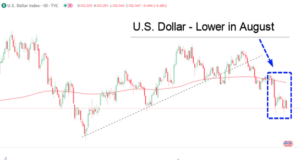What’s Changed in the Market Over the Past Two Weeks?
August 16, 2024
To Inform:
I fully realize I’m not following the first rule of investment management by focusing on the short term. I’m hoping clients and friends will do as I say and not as I do by focusing on the long term! That said, there has been a lot of volatility the past couple of weeks in markets and as I look forward to The Joseph Group’s Investment Strategy Team (IST) meeting next week, I want to know – what has really changed?
First some perspective. Below is a chart of the S&P 500 from July 31 through the morning of August 16. If you didn’t watch the news or open a newspaper, you’d say nothing has happened – the S&P 500 index of U.S. stocks is at the same place it was a couple of weeks ago. However, on August 5, the S&P hit a low point which represented about a 7% drop over two trading days. Why? Putting politics aside, we would point to two key narratives coming out of Wall Street:
- A slowing employment picture creating concerns of a broader economic slowdown.
- Currency movements in the Japanese yen spurring a fast unwinding of “carry trades.” The quick recovery in the stock market seems to give this view some credence.

Source: Yahoo Finance
Whatever the reason, a quick two-day drop in the stock market of -7% brings questions of what may lie ahead, but with the benefit of hindsight, we can see, looking over the last couple of weeks the market has bounced around but is unchanged. If the S&P 500 hasn’t changed, what has? We will point to a few observations:
- The market seems even more certain the Fed will cut rates later this year. The current upper band for the Fed Funds rate, the short-term interest rate controlled by the Fed is 5.5%. According to the CME Fed Watch as of 8/16, the odds of one 0.25% rate cut at the Fed’s September meeting is 74% and the odds of a 0.50% cut is 26%. In other words, the market is pricing in 100% certainty of a Fed cut in September. In December, the market is pricing in 3-5 total rate cuts between now and the end of the year.
- Long-term interest rates are lower/bond prices are higher. The widely accepted benchmark for longer-term interest rates is the rate on the 10-year Treasury note, which is set by the market. This rate is extremely important from an economic perspective because it influences other areas of the market such as mortgage rates. As of July 31, the rate on the 10-year Treasury was 4.10% compared to 3.89% today. The rate was as high as 4.7% in April, but the decline to 3.9% puts the rate back to where it was at the start of the year. The decline in longer-term rates is important because it means mortgage rates are generally lower and since interest rates and bond prices have an inverse relationship (think two ends of a teeter-totter), bond prices are higher and bonds in portfolios are generally showing positive YTD returns.

Source: CNBC
- The U.S. Dollar is trading lower. Our always calm trader, Andrew Burkey, pointed out another thing “different” over the last few weeks is that the U.S. dollar is trading lower. A lower dollar makes sense with lower interest rates, but is important because all else equal, a lower dollar provides support for commodities like oil and gold, as well as international stocks for U.S. investors.

Source: Tradingview
- Stock buying by company insiders has picked up the past couple of weeks. A report from Bloomberg this week indicated a major investment bank saw record volumes across its corporate buyback desk during the recent pullback in stocks. We don’t know which stocks, but corporate insiders stepping up to buy when stock prices declined is something we view as a positive sign for the big picture outlook.
We’ve seen a lot of activity but sideways movement for most areas of the stock market over the past couple of weeks. Although not much has changed for stocks, we are noting changes in the interest rates and the dollar, as well as an increase in buying by company insiders. What do we make from all of this? First, the volatility of the last few weeks seems like more noise than signal, and second, the shift in rates could imply we are entering a slower, but still positive growth phase for the economy.
I’ll use the second point to make a shameless plug for our Portfolios at Your Place Zoom event next Wednesday, August 21 at 4pm. Our Chief Investment Officer Alex Durbin will lead a discussion focused on where we stand in the current economic cycle along with a discussion of implications of the pending Presidential election. If you are curious about learning more, please tune in and invite a friend!

Written by Travis Upton, Partner and Chief Executive Officer